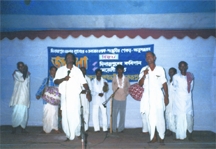Kavigan
Kavigan a genre of competitive folk songs performed by two groups of poetic singers. The chief of each group is called kaviyal or sarkar. The accompanying singers are called dohars. The dhuli or drummer plays a prominent role among the accompanying musicians. The two groups of singers sing in turns on stage. Kavigan has several parts: dak, malsi, sakhisangbad, kavi, kavir tappa, panchali, dhuya and joter palla. Malsi, sakhisangbad and kavi are similar in style. The different stages in kavigan are dharan, padan, fukar, mish, mukh, pyanch, khoch, antara, parchitan, chhutti. The dak comprises of the vandana, an introductory song of praise. Dhuya songs resemble baul songs and are performed at intervals with panchali songs. In the panchali, the kaviyals recite verses extempore in Bangla metres of payara (couplets) and tripadi (lines arranged in sets of three). The joter palla concludes the song with the kaviyals reciting verses in a singsong voice. In the other parts of the performance, the kaviyals perform along with their other companions on stage. In joter palla, however, both the kaviyals stand facing each other.
Kavigan developed in the eighteenth century, but became a popular entertainment for the new middle class Kolkata literati at the beginning of the nineteenth century. gonjla guin, born towards the beginning of the eighteenth century, is called the first kaviyal. The famous kaviyals of Kolkata in the nineteenth century were haru thakur (1749-1824), Nitai Vairagi (1751- 1821), Ram Basu (1786-1828), bhola maira, anthony firingee. Kavigan started losing its importance towards the end of the nineteenth century.

However, its popularity remained unimpaired in the rural areas of Bengal .Tarakchandra sarker (1845-1914) was a renowned kaviyal of this period. The kaviyals who gained popularity in twentieth-century Bangladesh are haricharan acharya (1861-1941), ramesh chandra shil (1877-1967), Rajendranath Sarkar (1892-1974), Bijaykrishna Adhikari (1903-1985). [Swarochish Sarker]
